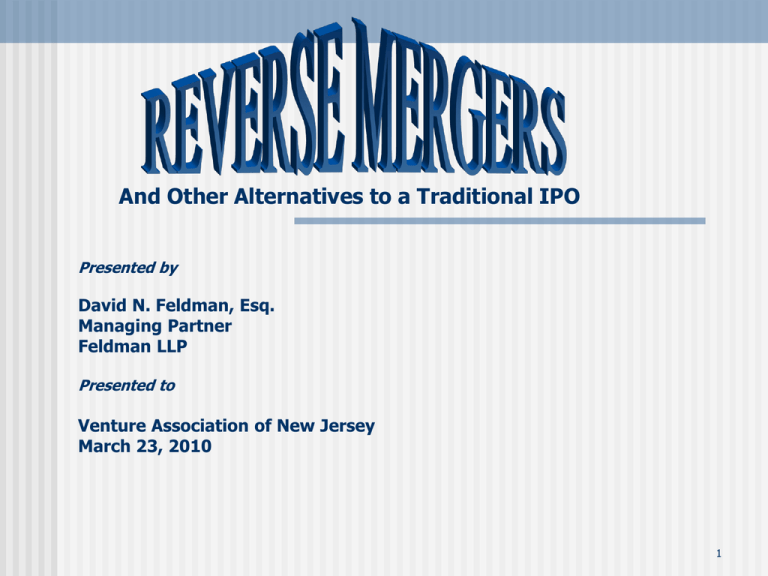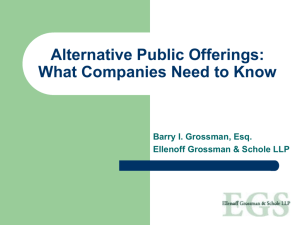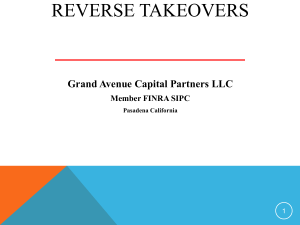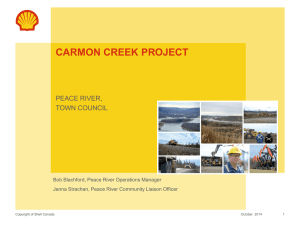GOING PUBLIC THROUGH A “REVERSE MERGER” THE
advertisement

And Other Alternatives to a Traditional IPO Presented by David N. Feldman, Esq. Managing Partner Feldman LLP Presented to Venture Association of New Jersey March 23, 2010 1 Topics 1. 2. 3. 4. 5. 6. 7. 8. Brief overview and introduction to reverse mergers and other alternatives to traditional IPO's Why now? Advantages of reverse mergers vs. IPOs Latest SEC rules and their impact China: Land of Opportunity The WRASP Structure Self-Filings SPAC’s 2 Introduction Public shell companies and the shell market Reverse triangular merger and other structures Rule 419 and its progeny Brief Review of Latest SEC Rulemaking Importance of financing Challenge of market support 3 Why now? A combination of factors led to the current reverse merger popularity: Maturation of industry Latest SEC Rules End of smallcap IPO’s and more recently IPO’s in general New stage in the company growth cycle Changes in PIPE market Coming to America “WRASP” Structure – bypass OTC Bulletin Board 4 Advantages of Reverse Mergers over IPO’s ►Lower costs ►Quicker process ►No IPO window necessary ►Less management attention required ►No risk of underwriter withdrawal ►Less dilution ►No underwriter 5 Latest SEC rules and their impact In June 2005, the SEC passed a rule change requiring substantial and timely disclosure following a reverse merger with a shell company (which is an SEC reporting company). It was effective November 2005. The rule states: • Within 4 business days following a reverse merger with a shell company (or other transaction that effects a change in control or makes the shell no longer a shell), the entity must file a Form 8-K containing the information that would be required in a Registration Statement on Form 10 • Form 8-K must include audited and pro forma financials • “Shell company” defined as having no or nominal assets (other than cash) and no or nominal operations (intentionally vague) 6 Latest SEC Rules continued • The rule also amended Form S-8 to prohibit its use by shell companies (Form S-8 is used to register securities for offer and sale in connection with an employee benefit plan). Shell companies may use Form S-8 sixty days after filing its Form 8-K in connection with its reverse merger. The rule applies equally to foreign companies. Rule is generally hailed as positive development leading to more transparent transactions and being troublesome only to unsavory players. Effect is more on process than structure, except that audit is now completed prior to closing. 7 Latest SEC Rules continued o Rule 144 Changes Effective February 15, 2008: • Eliminated bar on use of Rule 144 by shell holders • Require hold until one year after release of “Form 10 information” • “Evergreen” requirement to be current for 12 months prior to Rule 144 sale – controversial, request for rulemaking submitted to eliminate • Pink Sheet non-reporting never have Rule 144 after ceasing to be a shell until Form 10 information plus one year 8 China: Land of Opportunity o o o o Effect of U.S. capital markets • More than 25% of about 200 annual reverse mergers in the last few years involved Chinese companies Challenges in PRC regulatory environment • Decrees in 2005 (Circulars 10, 11, 29, and 75) • SAFE 106 • SAFE 142-August 2008 Other Obstacles • Due Diligence, Language, Culture, Auditing Outlook: Good! • Another PIPEs and RM conference scheduled in Shanghai this upcoming May 9 The WRASP Structure o o o o WestPark Capital’s Richard Rappaport developed this structure to take companies public without an IPO, trading shell, or self-filing PIPE and reverse merger followed by small secondary public offering Rise in popularity and legitimacy • Over a dozen completed deals since its creation in 2007 Benefits of being public optimized • Immediately listed on a higher exchange • Greater market support 10 Self Filings Private company requirements Sufficient shareholder base & shareholder status Timing and valuation of financing Wall Street savvy advisor or management team PRC company uses ADRs or new US parent Benefits • Avoid hassles such as due diligence, scrubbing a shell and negotiating with shell promoters • Retain equity • Avoids Rule 144 restrictions on former shells Drawbacks • More time consuming • Possible delays in financing – but helped by 2007 interpretation 11 SPAC’s – Currently Dormant.. Benefits Over an IPO • Quicker and less expensive • No negotiating with underwriter • Less focus on IPO window • Money accounted for and price is set • Seasoned management team Drawbacks Over another reverse merger • Cash (over $5 million) • Active trading market • Completely clean shell • Professional players Over self filing • Cash • Quicker • Wall Street savvy team SPAC’s • May have less market support than an IPO • Require the expensive process of preparing an investor proxy • May not gain shareholder approval of merger • Have an industry or marketplace focus which limits the field of potential companies to merge with • Give the company less control than self filings • Cause more dilution to management post merger than self filings Other Concerns: • Overhang of warrants • 20% of company given to SPAC management • Two-year time limit 12 For more information… o “Reverse mergers and self-filings are important alternatives to traditional IPOs, but with recent developments in the market, these transactions have become more complex than ever. David Feldman’s 2nd edition of Reverse Mergers explains these important developments in plain English and is an invaluable resource to any participant involved in the business of taking small companies public.” • Timothy J. Keating, President, Keating Investments, LLC 13 Questions? David N. Feldman, Esq. Managing Partner Feldman LLP 420 Lexington Avenue, Suite 2620 New York, NY 10170 T: (212) 931-8700 F: (212) 997-4242 dfeldman@feldmanllp.com www.feldmanllp.com 14











